Jianxing Zhang
Deep RAW Image Super-Resolution. A NTIRE 2024 Challenge Survey
Apr 24, 2024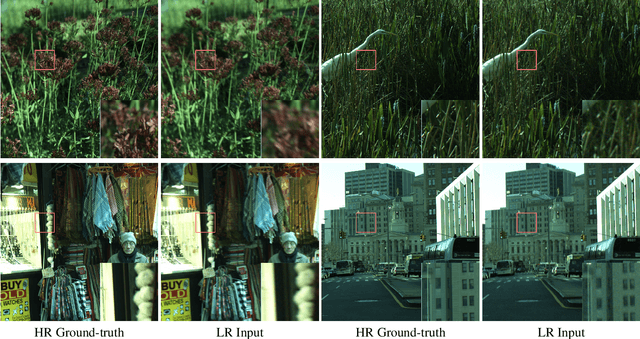

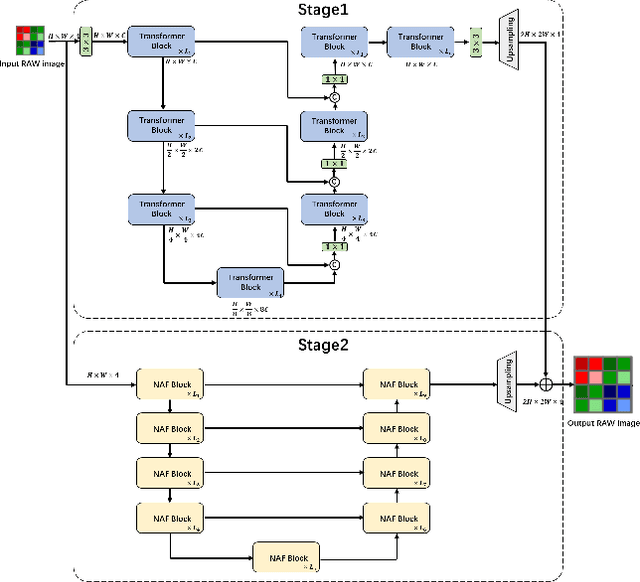
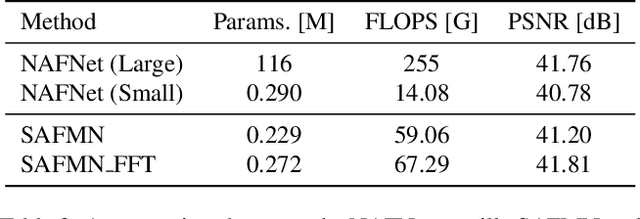
Abstract:This paper reviews the NTIRE 2024 RAW Image Super-Resolution Challenge, highlighting the proposed solutions and results. New methods for RAW Super-Resolution could be essential in modern Image Signal Processing (ISP) pipelines, however, this problem is not as explored as in the RGB domain. Th goal of this challenge is to upscale RAW Bayer images by 2x, considering unknown degradations such as noise and blur. In the challenge, a total of 230 participants registered, and 45 submitted results during thee challenge period. The performance of the top-5 submissions is reviewed and provided here as a gauge for the current state-of-the-art in RAW Image Super-Resolution.
Bridging Data-Driven and Knowledge-Driven Approaches for Safety-Critical Scenario Generation in Automated Vehicle Validation
Nov 18, 2023



Abstract:Automated driving vehicles~(ADV) promise to enhance driving efficiency and safety, yet they face intricate challenges in safety-critical scenarios. As a result, validating ADV within generated safety-critical scenarios is essential for both development and performance evaluations. This paper investigates the complexities of employing two major scenario-generation solutions: data-driven and knowledge-driven methods. Data-driven methods derive scenarios from recorded datasets, efficiently generating scenarios by altering the existing behavior or trajectories of traffic participants but often falling short in considering ADV perception; knowledge-driven methods provide effective coverage through expert-designed rules, but they may lead to inefficiency in generating safety-critical scenarios within that coverage. To overcome these challenges, we introduce BridgeGen, a safety-critical scenario generation framework, designed to bridge the benefits of both methodologies. Specifically, by utilizing ontology-based techniques, BridgeGen models the five scenario layers in the operational design domain (ODD) from knowledge-driven methods, ensuring broad coverage, and incorporating data-driven strategies to efficiently generate safety-critical scenarios. An optimized scenario generation toolkit is developed within BridgeGen. This expedites the crafting of safety-critical scenarios through a combination of traditional optimization and reinforcement learning schemes. Extensive experiments conducted using Carla simulator demonstrate the effectiveness of BridgeGen in generating diverse safety-critical scenarios.
Improving Classification Model Performance on Chest X-Rays through Lung Segmentation
Feb 22, 2022



Abstract:Chest radiography is an effective screening tool for diagnosing pulmonary diseases. In computer-aided diagnosis, extracting the relevant region of interest, i.e., isolating the lung region of each radiography image, can be an essential step towards improved performance in diagnosing pulmonary disorders. Methods: In this work, we propose a deep learning approach to enhance abnormal chest x-ray (CXR) identification performance through segmentations. Our approach is designed in a cascaded manner and incorporates two modules: a deep neural network with criss-cross attention modules (XLSor) for localizing lung region in CXR images and a CXR classification model with a backbone of a self-supervised momentum contrast (MoCo) model pre-trained on large-scale CXR data sets. The proposed pipeline is evaluated on Shenzhen Hospital (SH) data set for the segmentation module, and COVIDx data set for both segmentation and classification modules. Novel statistical analysis is conducted in addition to regular evaluation metrics for the segmentation module. Furthermore, the results of the optimized approach are analyzed with gradient-weighted class activation mapping (Grad-CAM) to investigate the rationale behind the classification decisions and to interpret its choices. Results and Conclusion: Different data sets, methods, and scenarios for each module of the proposed pipeline are examined for designing an optimized approach, which has achieved an accuracy of 0.946 in distinguishing abnormal CXR images (i.e., Pneumonia and COVID-19) from normal ones. Numerical and visual validations suggest that applying automated segmentation as a pre-processing step for classification improves the generalization capability and the performance of the classification models.
COVID-19 Detection from Chest X-ray Images using Imprinted Weights Approach
May 04, 2021
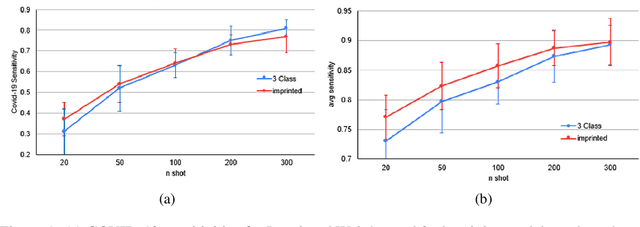
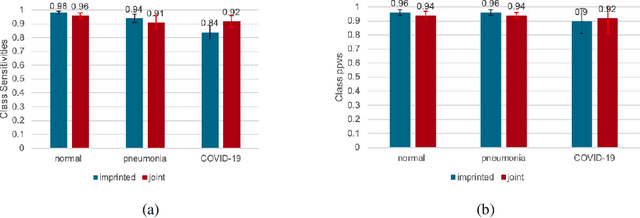
Abstract:The COVID-19 pandemic has had devastating effects on the well-being of the global population. The pandemic has been so prominent partly due to the high infection rate of the virus and its variants. In response, one of the most effective ways to stop infection is rapid diagnosis. The main-stream screening method, reverse transcription-polymerase chain reaction (RT-PCR), is time-consuming, laborious and in short supply. Chest radiography is an alternative screening method for the COVID-19 and computer-aided diagnosis (CAD) has proven to be a viable solution at low cost and with fast speed; however, one of the challenges in training the CAD models is the limited number of training data, especially at the onset of the pandemic. This becomes outstanding precisely when the quick and cheap type of diagnosis is critically needed for flattening the infection curve. To address this challenge, we propose the use of a low-shot learning approach named imprinted weights, taking advantage of the abundance of samples from known illnesses such as pneumonia to improve the detection performance on COVID-19.
Computer-aided Tumor Diagnosis in Automated Breast Ultrasound using 3D Detection Network
Jul 31, 2020
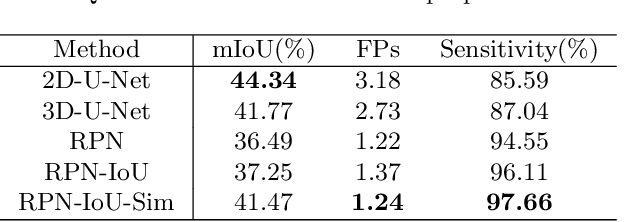
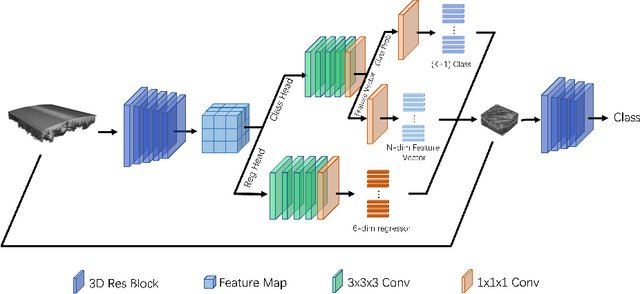

Abstract:Automated breast ultrasound (ABUS) is a new and promising imaging modality for breast cancer detection and diagnosis, which could provide intuitive 3D information and coronal plane information with great diagnostic value. However, manually screening and diagnosing tumors from ABUS images is very time-consuming and overlooks of abnormalities may happen. In this study, we propose a novel two-stage 3D detection network for locating suspected lesion areas and further classifying lesions as benign or malignant tumors. Specifically, we propose a 3D detection network rather than frequently-used segmentation network to locate lesions in ABUS images, thus our network can make full use of the spatial context information in ABUS images. A novel similarity loss is designed to effectively distinguish lesions from background. Then a classification network is employed to identify the located lesions as benign or malignant. An IoU-balanced classification loss is adopted to improve the correlation between classification and localization task. The efficacy of our network is verified from a collected dataset of 418 patients with 145 benign tumors and 273 malignant tumors. Experiments show our network attains a sensitivity of 97.66% with 1.23 false positives (FPs), and has an area under the curve(AUC) value of 0.8720.
 Add to Chrome
Add to Chrome Add to Firefox
Add to Firefox Add to Edge
Add to Edge